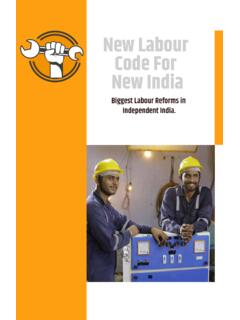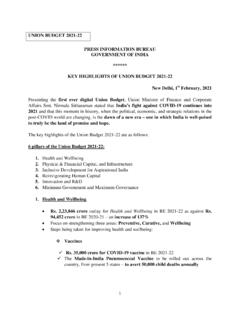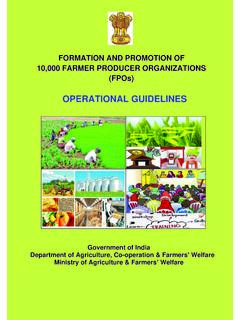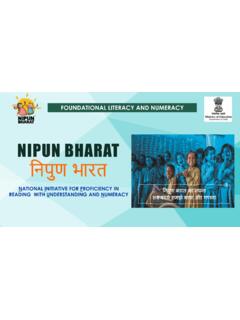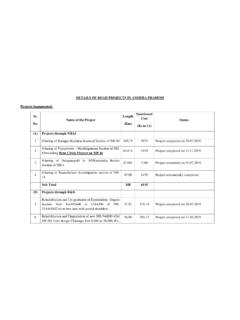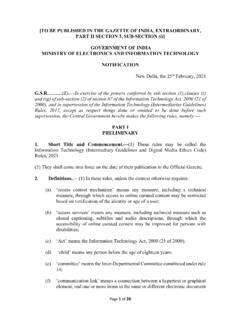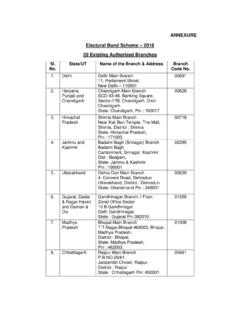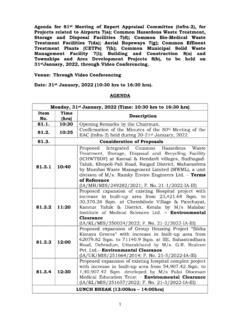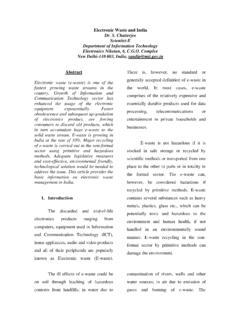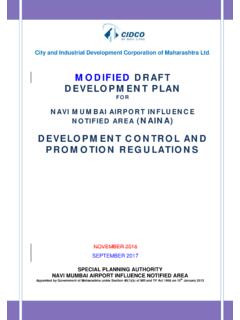Transcription of India Country Status Report - Press Information Bureau
1 India Country Status Report on Hydrogen and Fuel CellsDepartment of Science and Technology New DelhiMarch 2020Dr. Sanjay Bajpai HeadTechnology Mission Division (EW)Department of Science & Technology (DST) ,JaipurandpursuedmastersinBusinessAdmini strationfromUniversityofRajasthan, AlternativeFuelsforInternalCombustionEng ines .Hehasmanagedandshapedseveralnational,bi lateralandmultilateralresearch, , , sGroup,UlmUniversity,Germany, ,MinistryofScienceandTechnology,Departme ntofScienceandTechnology(DST),Government ofIndia,NewDelhi, ,hewasaPostdoctoralResearcheratUniversit yofChile,Santiago, ,hespenttwoyearsasaPost-DoctoralScientis tatStockholmUniversity,Stockholm, ,hewasaResearchScientistatCFN,Brookhaven NationalLaboratory,NewYork, ,NewYork,USA,hespentanother2years4months (2011-2013)
2 AsaResearchScientistatINL-InternationalI berianNanotechnologyLaboratory,Braga, ,hewasanAssociateProfessorandGroupleader atNanostructuredHybridFunctionalMaterial s&Devices,JainUniversity,Bangalore, ,hewasaScientistD&DeputySecretaryatTechn ologyMissionDivision,MinistryofSciencean dTechnology,DepartmentofScienceandTechno logy(DST),GovernmentofIndia,NewDelhi, , Nanotools&Nanomachines ,includinglowcostphotovoltaic(Organic,an dhybridsolarcells)andelectricalenergysto rage(batteriesandsupercapacitors),synthe sisofsemiconductingpolymersandpolymernan ostructuresandtheirapplicationtoorganict ransistors,solarcells,lightemittingdiode sandotherphotonicapplications,synthesis, characterizationsandapplicationsofcarbon andinorganicnanotubes, Ranjith Krishna PaiDirectorTechnology Mission Division Department of Science & Technology (DST)New DelhiProf.
3 PratibhaSharmaDepartment of Energy Science and EngineeringIndian Institute of Technology slevelandforherePhDwork,received Bestthesisaward , ,reviewerforseveralrenownedInternational Journals, , OutstandingServiceAward bytheInternationalAssociationofHydrogenE nergy, Scientist and Team LeaderCentre for Fuel Cell Technology, ARCIIIT Madras Research Park, Chennai, ,Madras,sheworkedaspostdoctoralfellowinT HDarmstadt,GermanyandUniversityofGeneva, , , ,unitofARCI, ,BharatVikasAwardfromInstituteofselfReli anceforcleanenergygeneration,Naturepubli shingawardetc.,Shehaschairedmanysessions andgiveninvitedtalksinvariousInternation alconferencesonFuelcellscience,Engineeri ngtechnology,GordonResearchConferenceonF uelcells,SocietyofAutomobileEngineersetc .
4 , ,Hydrogenutilization,IEEJ,Japan,American chemicalsociety,InternationalAssociation ofHydrogenenergy,MaterialsResearchsociet yofIndia,Electrochemicalsociety, , P. MuthukumarDepartment of Mechanical EngineeringIndian Institute of Technology Guwahati December2000,June-July2008, ( India ).HereceivedBhaskaraAdvancedSolarE nergyFellowship(BASEF ellowship) (USIEF), ( India ), ( India ).HeisoneoftheCommissionMembertore presentIndiaintheInternationalInstituteo fRefrigeration(IIR).HealsoreceivedFulbri ght-NehruAcademicandProfessionalExcellen ceFellowshipfrom(USIEF).HeservedasthePre sident,IndianSocietyofHeating,Refrigerat ingandAirConditioningEngineers(ISHRAE), MechanicalEngineeringDesignAward2017,fro mNationalDesign&ResearchForum(NDRF)of TheInstitutionofEngineers( India ) , ,hehasbeenhonoredasEminentEngineer-2019f rom TheInstitutionofEngineers( India )
5 , ,energystorage,refrigeration,heattransfe r, ,MNRE,QatarResearchBoard, ,metalhydridebasedthermalmachines,couple dheatandmasstransferinporousmedium,porou smediumcombustion,sorptionheatingandcool ingsystems, OF CONTENTSH ydrogen Production 1 IntroductionHydrogen StorageHydrogen TransportUtilization Fuel CellWay Forward8213235496367 Utilization-OthersReferences 1 | P a g e India Country Status Report on Hydrogen and Fuel Cells 1. Introduction India with a population of approx. billion is the second most populous Country and the third largest economy (measured by purchasing power parity) in the world. With significant decrease in poverty level, increased energy access for citizens, availability of cleaner cooking fuel and growing penetration of renewables, the Country is advancing on a faster growth path.
6 The Country s total primary energy supply (TPES) is Mtoe (coal accounting for , oil , bioenergy and waste , natural gas , hydro , nuclear , wind and solar )1. The TPES per capita is toe and energy consumption per capita being toe1. India s per capita energy consumption stands at 30% of the world s average. With the faster economic expansion in the Country the energy demand is rising in almost all sectors industry, commercial, residential, agricultural and transport. India s energy system is largely dependent on fossil fuels coal for power generation, oil for transport & industrial sector and biomass for residential heating & cooking.
7 Two thirds of the TPES is meet by domestic production and thus the Country is largely dependent on oil and gas imports. In the year 2018, the breakup of India s net import was million tons of oil and its products, Mtoe of gas and Mtoe of coal accounting for of the total primary energy consumption (TPEC). Major consumption is in the Industrial sector (42% of the total final consumption TFC) followed by residential (29% of TFC), transport (17% of TFC) and services (12% of TFC)1 as shown in Figure1. The rapid growth in the total final energy consumption and electricity being met largely by fossil fuels. Figure 1. India s total primary energy supply (TPES) and total final consumption (TFC) India is the world s third largest consumer of oil, for which Country has to depend heavily on oil imports.
8 India s oil refining capacity is the fourth largest in the world and the Country is a major exporter of the refined products. Government of India is pursuing roadmap to continue being the refining hub and expand its capacity with a plan through 2040. However, currently the dependence on oil import is 80% and is expected to grow further. Another important fuel which is natural gas, is currently 6% in the energy mix the aim is to increase its share to 15%. As per the projections, India s energy demand could double by 2040 and electricity demand triple. With the rise in energy demand the major impact will be on environment. The energy sector is considered to be the major source for environmental concerns, including the local air pollution, GHG emissions and thus accounting for the implications associated with climate change.
9 Thus, there is a penetrating need of addressing the growth of energy demand, at the same time providing clean energy to the masses and keeping the climate change threats under consideration. 2 | P a g e India Country Status Report on Hydrogen and Fuel Cells The increasing air pollution in several cities of the Country ( Delhi, Gurugram, Noida, Faridabad, Kanpur etc.), is the key concern, energy sector has been identified as the major source of emissions. Sometimes the high concentrations of air pollutants have been reported even due to the non-energy sector related emissions from crop burning etc. Out of the top 20 most polluted cities in world, ten in the list are from India .
10 The situation is really alarming as in the year 2017 this problem has caused around million pre-mature deaths. The Government of India has laid several policies and is targeting to provide sustainable and affordable solutions, reduce emissions and lay down a path for economic growth. Several steps have been taken to address the climate change and local air pollution threats The National Green Tribunal has revised the standards in terms of the emission norms for thermal power plants and restricted the particulate matter to 30mg/m3, NOx and SOx emissions to 100 mg/m3. The major NOX emissions are arising from transport sector (40% of total), power sector (31%) and industrial sector (20%).
